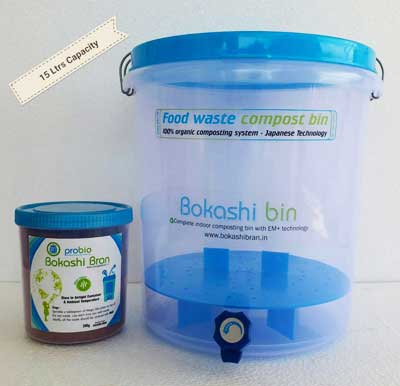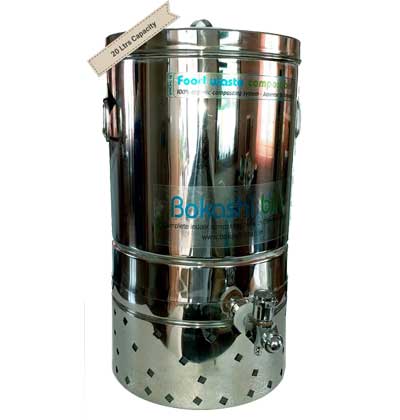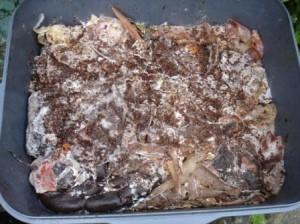

Most home composting systems will break down garden waste and uncooked kitchen waste such as vegetable and fruit peelings, but cannot be used to dispose of cooked food, meat, fish or dairy products. These materials need special treatment as they tend to putrefy, producing rotting smells and attracting flies and vermin, so often they are just put in the bin and sent off to landfill.
There are several methods of dealing with kitchen waste at home, producing useful compost for the garden and reducing the amount of waste going to landfill. These include food digesters which uses a hot composting system to treat both garden and kitchen waste together. Or another option is to use a normal composting system along with either a worm composting or a bokashi system.
Bokashi bins are generally quite small, and are intended to be kept in or near the kitchen. They can be kept outdoors, but in colder conditions the fermentation process slows down and takes longer.
 Fermented Waste
Fermented Waste
It is important to drain off any juice from the bucket every couple of days during the fermentation period, and wait at least 2 weeks before opening the container to allow the process to complete. When ready, the fermented waste will have a quite pleasant yeasty, sweet and sour smell, similar to that of pickles or cider vinegar.
Bokashi treated waste is not composted in the bucket, and the food will look much the same as it did when it was put in – bread will still look like bread – although the process does change the structure of the food. Sometimes a white cotton-like fungal growth appears on the surface – this is not a problem, and indicates that good fermentation has taken place.
The Bokashi waste has now been pickled and can be safely added to a worm bin, a normal compost bin or heap, or dug straight into the garden, where it will compost down very quickly.
Rinse the bucket out with water after each use – do not use chlorine based cleaner.
If you are putting the fermented waste directly into the garden, dig a hole or trench approximately 20-25 cm deep, add the fermented waste and mix in some soil, then cover with the remaining soil. Bokashi mixtures are acidic when first dug in, so ensure plant roots do not come directly into contact with the fresh waste as it may burn the roots, particularly in young plants. The mix will neutralize after 7-10 days, so it’s best to wait a couple of weeks before adding any plants.
This system accelerates the composting process – bacteria in the soil and waste will break down the organic material very quickly – in about 3 weeks it will have completely decomposed.
If you are short of space for digging a new hole each time the bucket needs emptying, you can create a disposal point by digging a deep hole, placing gravel or small stones in the bottom, then place a large bottomless plastic bin with a strong lid up to its rim in the ground and fill in the soil around it. Tip in the fermented bokashi mix, stir in a little soil, and replace the lid.
You can also use the bokashi mix in planters, raised beds or pots – fill the container about one third full with potting mix, add the fermented bokashi and mix in, then fill up the rest of the container with more potting mix. Leave it to settle for a couple of weeks before planting up.
If adding the contents of the bucket to a worm bin or compost heap, spread the fermented waste out and mix with a little compost to speed decomposition, then cover over with more compost. Worms will avoid the waste for a few days until the acidity has reduced.
Sometimes a liquid is produced during fermentation, although don’t worry if there is none, as the amount and colour of the liquid depends on the type of foods you have put into the bucket – fruit and vegetables will produce more than other foods. Any liquid will drain into the bottom of the bucket and should be drawn off every couple of days. This liquid doesn’t keep well, and should be used within 24 hours of draining from the bucket.
Bokashi tea makes an excellent plant fertilizer as it contains the nutrients from the food waste and also Effective Micro-organisms (EMs). To fertilise garden or container plants use about 1 teaspoon (5ml) to 2-3 litres of water, or for established trees and shrubs use 2 teaspoons (10ml) to 2-3 litres of water. Always apply onto the soil, never directly onto foliage.

Established in the year 2015, Pioneer Agro Industry has been an exclusive store for urban gardening, Terrace Gardening, agriculture and farming.
Phone : +422-2563050, 2562552
Mobile : +91-9994994429, 9043094429
E-mail :
pioneeragro99@gmail.com
Pioneer Agro Industry
14, Pudur Main Road,
Peelamedu,
Coimbatore – 641004
Tamilnadu
India